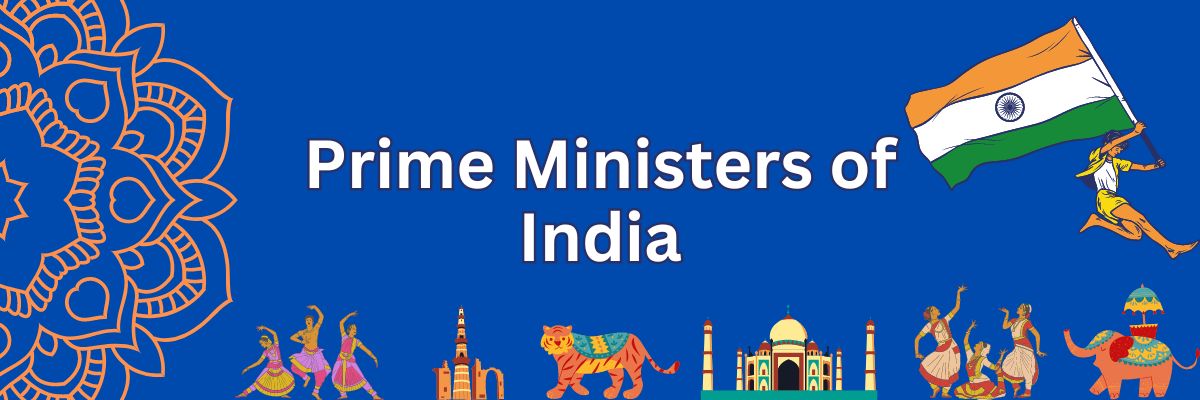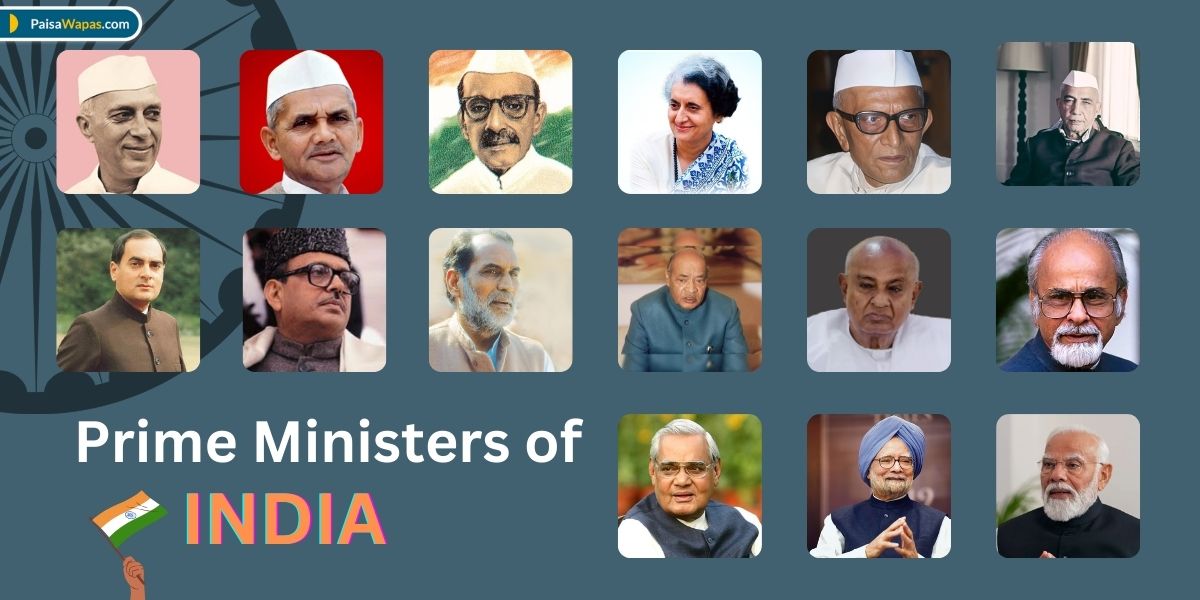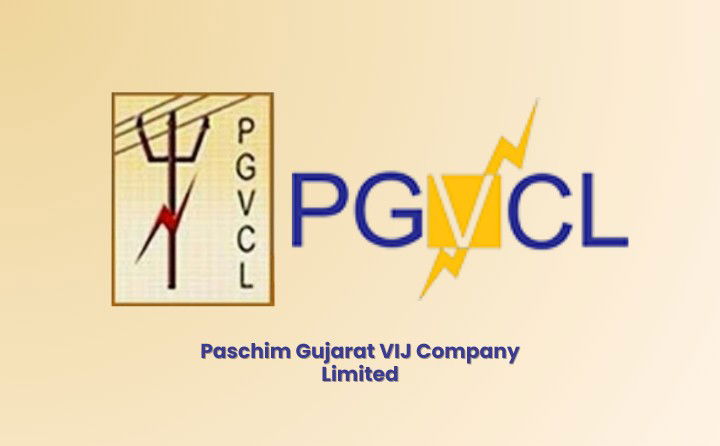list of Indian Prime Ministers: In India, the Prime Minister is the chief of state and leader of the Council of Ministers. The Prime Minister of India is appointed by the Indian President after a political party wins a general election; the person who leads the party is typically appointed Prime Minister.
He can be a member of the Rajya Sabha or the Lok Sabha and must be the head of the majority party or coalition in the Lok Sabha or the lower house of Parliament. The Prime Minister acts as the chief spokesperson or representative for all government policies and is liable for the administration of the government. If you’re looking for a list of Indian prime ministers from the oldest to the incumbent, read the information below!

List of Indian Prime Ministers with Notable Achievements:
- Jawaharlal Nehru
- Lal Bahadur Shastri
- Gulzarilal Nanda
- Indira Gandhi
- Morarji Desai
- Chaudhary Charan Singh
- Rajiv Gandhi
- V. P. Singh
- Chandra Shekhar
- P. V. Narasimha Rao
- H. D. Deve Gowda
- Inder Kumar Gujral
- Atal Bihari Vajpayee
- Manmohan Singh
- Narendra Modi
1. Jawaharlal Nehru (1947 to 1964):
The longest-serving and first prime minister of India, Jawaharlal Nehru was a prominent figure in the independence movement of India. He was widely known as “Chacha Nehru” due to his affection and love towards children.
Date of Birth: November 14, 1889
Death Date: May 26, 1964
Most notable achievement: 1st Prime Minister of India and served India for the longest period. He is an important figure in the independence movement.
2. Lal Bahadur Shastri (1964 to 1966):
He was a congressman who originated the slogan, “Jai Jawan Jai Kisan” that became worldwide attention. Lal Bahadur Shastri also served as the Railway Minister under Pandit Jawaharlal Nehru.
Date of Birth: October 2, 1904
Death Date: January 11, 1966
Most notable achievement: Invented the slogan – Jai Jawan, Jai Kisan, during the Indo-Pak war in 1965
3. Gulzarilal Nanda (1964, 1966):
After the death of Bahadur Shastri in 1966, he took over as acting Prime Minister of India for 13 days. His first 13-day slint took place as the second Prime Minister of India after the death of Prime Minister Nehru in the year 1964.
Date of Birth: July 4, 1898
Death Date: January 15, 1998
Most notable achievement: He was the 1st acting Indian PM (interim PM) after Shashtri and Nehru’s Deaths
4. Indira Gandhi (1966 to 1977, 1980 to 1984):
The only woman PM on the list of Indian prime ministers, Indira Gandhi served the 2nd longest term as a PM, and she also served as minister of external affairs, minister of home affairs, minister of defense, and minister of information and broadcasting. After Operation Blue Star, she was murdered by his bodyguard in 1986.
Date of Birth: November 19, 1917
Death Date: October 31, 1984
Most notable achievement: First Prime Minister of India (Women), an important figure of the Indian National Congress Party
5. Morarji Desai (1977 to 1979):
Morarji Desai was the 4th PM of India. From 1952 to 1956, he was the head minister of the Bombay state, which was divided into Gujarat and Maharashtra. Desai led the Indian government created by the Janata Party.
Date of Birth: February 29, 1896
Death Date: April 10, 1995
Most notable achievement: 1st Non-Congress Indian PM, economic reforms
Also Read: TOP 14 GREAT CRICKETERS OF ALL TIME
6. Chaudhary Charan Singh (1979 to 80):
5th Indian PM on the list of Indian prime ministers, C Charan Singh was born in UP in a peasant family. He was the expert on peasants’ rights.
Date of Birth: December 23, 1902
Death Date: May 29, 1987
Most notable achievement: Only the Indian Prime Minister has never addressed the legislature
7. Rajiv Gandhi (1984 to 89):
He was the 6th PM of India who served as a pilot for the Indian airlines. Rajiv Gandhi, from 1985 to 1991, was the president of the Congress Party. He was known for prominent cases, such as the Bhopal Gas Tragedy & the Bofors Scandal and Shah Bano. He was murdered in 1991 by an LTTE suicide bomber.
Date of Birth: August 20, 1944
Death Date: May 21, 1991
Most notable achievement: He became the youngest PM of India (at the age of 40)
Also Read: TOP 15 BOLLYWOOD GREATEST INDIAN SINGERS
8. VP Singh (1989 to 1990):
7th PM of India on India PM list, VP Singh was a congressman and the 12th CM of UP. He was the finance minister from 1984 to 1987 and the defense minister from 1989 to 1990. During his tenure, the Mandal Commission report was implemented for reservation in educational institutions or government posts.
Date of Birth: June 25, 1931
Death Date: November 27, 2008
Most notable achievement: He was India’s first prime minister to leave following a no-confidence vote and implemented the Mandal Commission report.
9. Chandra Shekhar (1990 to 1991):
He was the 8th PM of India who led a minority government of the breakaway faction of Janata Dal with the assistance of the Congress Party to delay the election process. Shekhar’s government was considered “stupid” with the party’s lowest no of MPs.
Date of Birth: July 1, 1927
Death Date: July 8, 2007
Most notable achievement: Chandra Shekhar headed the minority government
10. PV Narasimha Rao (1991 to 1996):
The 10th PM and the first PM belonged to Southern India, PV worked as the defense minister and the minister of external affairs from 1993 to 1996 and 1992 to 1994, respectively. In the PM list of India, PV was the 4th CM of Andhra Pradesh.
Date of Birth: June 28, 1921
Death Date: December 23, 2004
Most notable achievement: Served as the country’s first South Indian PM as he hailed from Andhra Pradesh
11. HD Deve Gowda (1996 to 1997):
The 11th Indian prime minister, HD held the office of chief minister of Karnataka (from 1994 to 1996). He was elected as Prime Minister when no party won enough seats to establish the government and the United Front formed the government with the support of the Congress.
Date of Birth: May 18, 1933
Death Date: still alive
Most notable achievement: Second South India’s PM as he is a Karnataka native.
12. Inder Kumar Gujral (1997 to 1998):
He was the 12th PM of India on the list of Indian Prime Ministers who were a participant in the Quit India movement under the leadership of Gandhi Ji. Inder was both a Lok Sabha and a Rajya Sabha member.
Date of Birth: December 4, 1919
Death Date: November 30, 2012
Most notable achievement: The 3rd Indian PM, after deve Gowda and Indra Gandhi, to come from the Upper house.
13. Atal Bihari Vajpayee (1996, 1998 to 99, 1999 to 2004):
Elected as the 10th Prime Minister of India, Vajpayee served for only 13 days. He was a famous Prime Minister who was awarded Bharat Ratna in 2014. Atal ji introduced the phrase “Jai Jawan, Jai Kisan, Jai Vigyan”. He was the Foreign Minister and is famous for his contribution to improving India-Pakistan relations.
Date of Birth: December 25, 1924
Death Date: 16 August 2018
Most notable achievement: First non-congress Prime minister to work full term (Pokhran nuclear tests)
14. Manmohan Singh (2004 to 2014):
The 13th PM of India, Manmohan Ji was the leader of the upper house (from 1998-2004). He is globally accredited for the LPG 1991 reforms in India. Singh was also the 15th governor of the RBI.
Date of Birth: September 26, 1932
Death Date: still alive
Most notable achievement: The first Indian Prime Minister comes from a minority community
15. Narendra Damodardas Modi (2014-Incumbent):
Apart from being the leader of the Lok Sabha, Modi ji is also the head of the Council of Ministers. He is the 14th Prime Minister of India and is serving his second term. He was elected for the first time in the year 2014.
Date of Birth: DOB: September 17, 1950
Death Date: still alive
Most notable achievement: He is India’s first PM who was born after independence and re-elected for two following terms.
List of Important Powers and Responsibilitys of Prime Minister:
The Indian Prime Minister, who is originally appointed by the President of India, is the backbone of the state. Usually, the leader of the winning political party is appointed Prime Minister. Here are the powers and responsibilities of the Prime Minister of India:
Powers:
- The Chief Head of the Indian Government: The Indian Prime Minister is the leader of the country.
- Chairman of the Cabinet: The Indian PM is the chairman of the cabinet, who organizes the Cabinet meetings. He can bind his decision if there is a significant difference of opinion and conflict among the members.
- Power of Portfolio allocation: The Indian Prime Minister has the power to allocate respective portfolios to the Ministers.
- Country’s official representative: Apart from being the ambassador of the country, the Indian PM represents the country for top-level foreign meetings.
- Leader of programs and organization: The Prime Minister of India is the leader of NITI Aayog, Nuclear Command Authority, Department of Atomic Energy, Appointments Committee of the Cabinet, Public Grievances and Pensions, and various other programs and organizations.
- Chief Advisor: The prime minister of India also serves as the chief advisor.
Duties:
- To report to the Indian president on all actions taken by cabinet ministers
- To inform the Indian president regarding any state of emergency or any other matter related to foreign policy or quick, urgent importance.
- To give information to the Indian president about the working of the Government of India and the Union.
Note: According to the different types of articles available in the Indian Constitution, the Prime Minister has various duties. The duties of the Prime Minister are specifically defined in the discharge of power in “Article 78” of the Constitution of India.
List of Indian Prime Ministers with Tenure Period:
The Prime Ministers of India serve for varying terms of office. While some serve in the PM post for a few years, others serve for a longer period. Pandit Jawaharlal Nehru, for instance, was the Indian Prime Minister who served for a long time (from 1947 to 1964). Some prime ministers, on the other side, served only for a short period. These also include Lal Bahadur Shastri, who served from 1964-1966. Each Prime Minister has his or her own time in office to lead the country.
Here is a list of PMs of India along with their specific tenure period:
| Indian Prime Ministers | Tenure Period |
| Jawahar Lal Nehru | 15 August 1947-27 May 1964 (16 years, 286 days) |
| Gulzarilal Nanda | 27 May 1964 to 9 June 1964(13 days) |
| Lal Bahadur Shastri | 9 June 1964 to 11 January 1966(1 year, 216 days) |
| Gulzarilal Nanda | 11 January 1966, 24 January 1966(13 days) |
| Indira Gandhi | 24 January 1966 to 24 March 1977(11 years, 59 days) |
| Morarji Desai | (24 March 1977 – 28 July 19792 years, 126 days) |
| Charan Singh | 28 July 1979 to 14 January 1980(170 days) |
| Indira Gandhi | 14 Jan.1980 to 31 Oct. 1984(4 years, 291 days) |
| Rajiv Gandhi | 31 Oct 1984 to 2 Dec 1989(5 years, 32 days) |
| V. P. Singh | 2 Dec 1989 to 10 Nov 1990(343 days) |
| Chandra Shekhar | 10 Nov 1990 to 21 June 1991(223 days) |
| P. V. Narasimha Rao | 21 June 1991 to 16 May 1996, 4 years, (330 days) |
| Atal Bihari Vajpayee | 16 May 1996 to 1 June 1996(16 days) |
| H. D. Deve Gowda | (1 June 1996 to 21 April 1997324 days) |
| Inder Kumar Gujral | 21 April 1997 to 19 March 1998(332 days) |
| Atal Bihari Vajpayee | 19 March 1998 to 22 May 2004(6 years, 64 days) |
| Manmohan Singh | 22 May 2004 to 26 May 2014(10 years, 4 days) |
| Narendra Modi | 2014-Present |
Frequently Asked Questions:
- Who was the first prime minister of India?
Pt. Jawaharlal Nehru was the first Prime Minister of India with the longest tenure (16 years and 286 days).
- Who is the first prime minister of India (women)?
The first and only women Prime Minister of India – Indira Gandhi
- Who became Prime Minister three times in India?
Atal Bihari Vajpayee was the only non-Congress Indian Prime Minister to date, serving three terms. Also, he was the 1st PM to complete a full five-year term.
- Who appoints the India’s Prime Minister?
The Indian President appoints the India’s Prime Minister.
- What is the age limit for the Indian Prime Minister’s Election?
If they are members of the Lok Sabha, they should be above 25 years of age. But if they are members of the Rajya Sabha, the age should be 30 years.
- How long has Narendra Modi been the Indian prime minister?
Modi has been serving as PM since 2014. From 2001 to 2014, he was the CM of the Gujarat State. Then he was elected as the PM of India (in 2014- May). He is a part of the BJP.












Add Comment